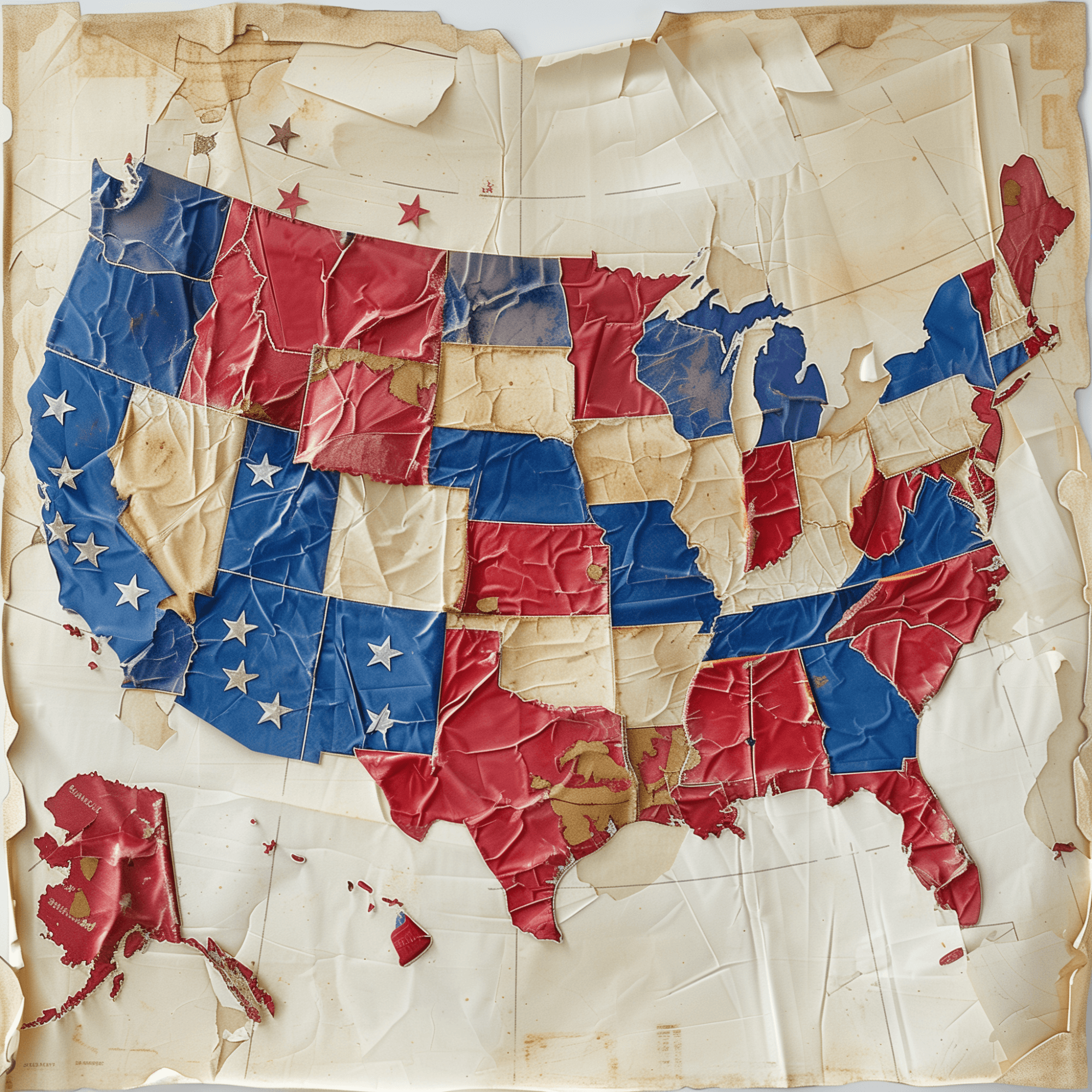
What Happens in a Contingent Election?
As complicated as the U.S. electoral system is, most are familiar with the number of electoral votes that a presidential candidate needs to win the election: 270. Once a candidate has secured at least 270 electoral votes, they have become the nation’s next president. But what happens if none of the candidates reaches that magic number? What if there’s a tie?
Although most presidential elections end with a clear winner, there is a constitutional mechanism in place for the unlikely scenario that no candidate secures a majority of electoral votes.
This mechanism, which is known as a contingent election, is not just a theoretical possibility. It’s a procedure that’s deeply embedded into the fabric of American democracy and specifically outlined by the 12th Amendment to the Constitution.
Contingent Elections and the 12th Amendment
A contingent election is triggered when no candidate for president or vice president achieves a majority of the votes in the Electoral College, the body of electors established by the Constitution to elect both the president and vice president of the United States.
The process for resolving such an impasse is detailed in the 12th Amendment, which was ratified in 1804 to refine the electoral process after the election of 1800 exposed significant flaws in the original electoral framework.
The 12th Amendment specifies that if no candidate receives a majority of electoral votes for president, the decision is transferred to the House of Representatives. Each state’s delegation in the House gets one vote, regardless of its size, and a majority of states (currently 26 out of 50) is required to elect the president.
This amendment also made selection of a vice president a separate action in the Electoral College. Prior to the election of 1800, the vice president was the runner-up in the presidential election. Although modern presidential tickets seem to be a package deal, with the candidate’s choice for VP being automatically ushered in after the election, this formality is still upheld.
In the rare and unusual case of a vice-presidential deadlock, the Senate takes charge. In this scenario, each senator casts one vote, with a majority of the total Senate (51 votes, if all are present and voting) needed to elect the vice president. This has happened only once, in 1837.
The Process of a Contingent Election
The process for selecting a president and vice president via contingent election is fairly straightforward, whatever the situation triggering the contingency.
The steps for electing a president through a contingent election are:
Transfer to the House: The election is moved to the House of Representatives, where each state delegation casts a single vote to choose among the top three electoral vote-getters for president.
Voting Procedure: All 435 members participate, but their votes are tallied by state, not individually, effectively giving each state one vote.
Majority Requirement: A candidate must receive the majority of the states’ votes (26) to win.
For the vice president, the process is even simpler. The Senate elects the vice president from the top two candidates. Each of the 100 Senators casts one vote, requiring a simple majority of 51 (if all are present) to win.
Historic Examples of Contingent Elections
The United States has witnessed this rare procedure unfold in its presidential elections only twice in our history, in 1800 and 1824. It was used again in 1837 to choose the vice president.
The Presidential Election of 1800
The first contingent election was triggered by a tie between Thomas Jefferson and Aaron Burr, both of whom received the same number of electoral votes. Since the vice presidency went to the runner up, this made determining the ultimate winner complicated.
The House of Representatives was tasked with breaking the tie, leading to Jefferson's eventual election after a prolonged and contentious process that included 37 votes to finally give the victory to Jefferson. It also led to the drafting of the 12th Amendment, which was ratified toward the end of his term.
The Presidential Election of 1824
“I have no hesitation in saying that I have ever considered the constitutional mode of election, ultimately by the legislature voting by the states, as the most dangerous blot in our constitution, and one which some unlucky chance will some day hit, and give us a pope and anti-pope” ~ Thomas Jefferson in a letter to George Hay, 1823
Perhaps the most contentious election, the 1824 presidential race saw John Quincy Adams elected over Andrew Jackson, despite Jackson having won more electoral and popular votes. This outcome, which was decided by the House, came to be known as the "Corrupt Bargain," a nickname highlighting the political maneuvering that can influence contingent elections.
The problem began with the collapse of the Federalist Party, and was further complicated when the leading contender from the Democratic-Republican Party, William H. Crawford, suffered a stroke, which hampered his campaign. After John C. Calhoun dropped out to run for vice president, there were three remaining candidates in the race, all from the same party.
Although Andrew Jackson won the popular vote and a plurality of the electoral votes, no candidate won the majority of 131+ needed to win. This triggered the nation’s second contingent election, and John Quincy Adams ultimately became the 6th president of the United States.
The corrupt bargain was said to have been entered into when John Calhoun convinced the House to vote in Adams, who then named Calhoun as his Secretary of State.
What Happened in 1876?
A contentious and confusing situation in 1876 almost led to a contingency when three states, Florida, Louisiana, and South Carolina, submitted two sets of electoral certificates, one for each of the two leading candidates. This was eventually resolved by a commission that was convened to review the ballots.
The party-line vote resulted in Rutherford B. Hayes being elected to the presidency by just one vote. It also led to the Compromise of 1877 that ended Reconstruction in the South.
These historical instances underscore the complex interplay between the Electoral College and the contingent election process, revealing how electoral norms and the balance of power can shift unexpectedly.
The Role of Faithless Electors
A possible wrinkle in the plan of a contingent election is the possible presence of “faithless electors.” Although the 12th Amendment and the Electoral College Reform Act of 2022 have cleaned up some loose ends and formalized the processes necessary to ensure a clean and fair election, there are no federal laws that govern how a contingent election is conducted.
This oversight could lead to several scenarios that, given the state of extreme polarization present in the country after 2020, could materialize in future elections.
The biggest threat is the possibility of faithless electors. These are rogue electors who vote against their pledge to certify the winner of the Electoral College. This is a situation that almost played out in 2020.
Congress leaves laws governing possible remedies for delegates who act against their oath to individual states, and the Supreme Court has upheld this remedy. Currently, 34 states and the District of Columbia have laws on the books to impose fines and replace such bad actors.
In a highly contentious presidential race, there is also the possibility of court challenges, a Senate filibuster, or manipulation of House voting rules. The 12th Amendment leaves these questions open with no fixed remedy.
For example, there is no set answer for what quorum is required to reach a decision within a delegation. Under the rules set by the Senate, 41 members could block the VP selection, leaving that position vacant. There is also no remedy in place if a president-elect dies before the vote is certified.
Each of these scenarios is highly unlikely. However, the events of the past few years leave an uncomfortable number of doors slightly ajar, if not open.
Concerns About a Contingent Election in 2024
Looking ahead to the 2024 presidential election, there are growing concerns about the possibility of a contingent election. These are fueled by an increasingly polarized political landscape and the potential for third-party candidates to “split” the presidential vote.
Critics argue that the process of a contingent election gives a disproportionate amount of power to smaller states and could lead to a president being elected by a minority of the population. This could raise questions about the legitimacy and democratic integrity of the election’s outcome.
Moreover, the highly partisan nature of contemporary American politics raises fears that a contingent election could lead to unprecedented political deadlock, undermining public confidence in the electoral process and potentially inciting civil unrest.
The role of party loyalty and strategic voting in Congress during a contingent election could further complicate the electoral process, with legislators potentially facing intense pressure to prioritize party over principle.
The Way Forward
The prospect of a contingent election highlights the unique and sometimes arcane features of the American electoral system, prompting calls for reform from various quarters. Proposals for reform range from abolishing the Electoral College in favor of a direct popular vote to modifying the contingent election process to ensure a more equitable and transparent resolution to electoral deadlocks.
As the United States moves closer to future elections, the debate over the contingent election process and its place in American democracy continues to gain momentum. Whether this mechanism remains a historical curiosity or becomes a pivotal factor in deciding a future president remains to be seen. Either way, its existence underscores the complex, evolving nature of democratic governance in America.
While the contingent election process is a testament to the foresight of the nation's founders in designing a flexible and resilient electoral system, it also reflects the challenges of adapting 18th-century solutions to 21st-century political realities.
Final Thoughts
As America grapples with electoral challenges, it becomes increasingly important for voters and policymakers alike to understand the mechanisms that power our democracy. That’s why voter education and civic engagement are so essential.
They’re a vital part of engaging with and reforming our political system to ensure that it reflects the will of the people.
Want to learn how you can get involved? GoodParty.org is leading the way with support for people-powered, anti-corruption local candidates and independents across the nation. Learn how you can join the movement and make an impact here.

